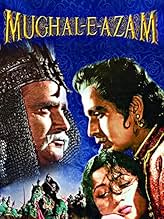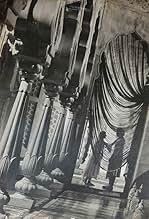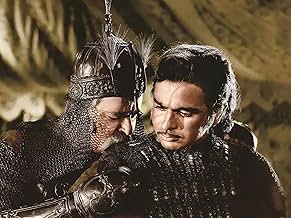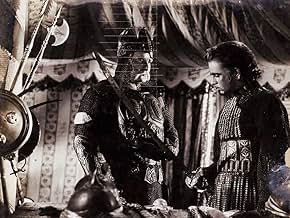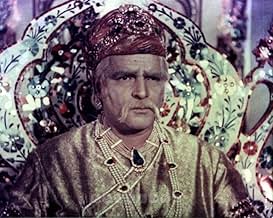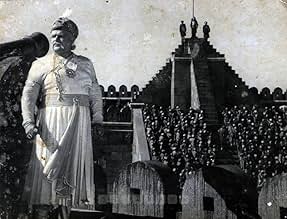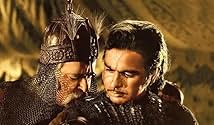NOTE IMDb
8,1/10
9,3 k
MA NOTE
Ajouter une intrigue dans votre langueA 16th century prince falls in love with a court dancer and battles with his emperor father.A 16th century prince falls in love with a court dancer and battles with his emperor father.A 16th century prince falls in love with a court dancer and battles with his emperor father.
- Réalisation
- Scénario
- Casting principal
- Récompenses
- 3 victoires et 3 nominations au total
Prithviraj Kapoor
- Emperor Akbar
- (as Prithviraj)
Ajit Khan
- Durjan Singh
- (as Ajit)
Jillo
- Anarkali's Mother
- (as Jillo Bai)
Sheila Dalaya
- Suraiya
- (as Sheela Delaya)
Tabassum Govil
- A Tawaif
- (as Baby Tabassum)
Avis à la une
Mughal-e-Azam is indeed a colossal of a movie and its spell binding appeal and courtly grandeur has been further enhanced by the recently released color version.
Dilip Kumar, the icon of Indian Cinema and its first super star as well, has rendered complete resonance to the hedonistic persona of prince Saleem. The love travails of the myth of Anarkali have been splendidly captured on the tinsel screen through the superb portrayal by both, Madhu Bala and legendary Dilip Kumar. Besides, Pirthvi RajKapoor has also projected the required prestige and magnitude to the role of Emperor Akbar. It is worth watching, another time in color scope.
Dilip Kumar, the icon of Indian Cinema and its first super star as well, has rendered complete resonance to the hedonistic persona of prince Saleem. The love travails of the myth of Anarkali have been splendidly captured on the tinsel screen through the superb portrayal by both, Madhu Bala and legendary Dilip Kumar. Besides, Pirthvi RajKapoor has also projected the required prestige and magnitude to the role of Emperor Akbar. It is worth watching, another time in color scope.
I haven't seen the black and white original of Mughal E Azam since the '80's, but I recently saw the restored revived colourised 2004 re-release for the first time and was astounded by the results. I'm not a believer in messing around with the originals, but bearing in mind director Asif always wanted to make the whole film in colour but didn't have enough money the "final" product is amazing to see - such is technology! It was incredibly expensive to make as it was, the restoration process must have cost a fabulous amount too.
Seminal Indian epic purporting to deal with events from about 400 years ago around Prince Saleem (Dilip Kumar) falling in love with a court dancer Anarkali (Madhubala) to his father Akbar's utter opposition and eventually causing a rift leading to all out war. The drama and war spectacle scenes are memorable enough, with thousands of humans and animals as extras, and the music is uniformly superb too. But it's Pyar Kiya To Darna Kya (If I have loved someone>why should I be afraid?) sung by Anarkali (Lata) to the 2 of them in the Hall Of Mirrors that is absolutely stunning - I will have to get the original and compare, because the remaster seems to have turned this song into something even more magical and mesmerising than I remembered. It took Naushad and Shakeel Badayuni one night to compose music and lyrics so timeless - a colourful piece of poetry in motion, with the insistent kaleidoscopic climax added by Asif. Awesome! According to the legend it was supposed to have an unhappy ending - needless to say I'm glad it was altered here to a happy one after such a roller-coaster ride!
A tremendous work of Art, showing the very best of Indian cinema.
Seminal Indian epic purporting to deal with events from about 400 years ago around Prince Saleem (Dilip Kumar) falling in love with a court dancer Anarkali (Madhubala) to his father Akbar's utter opposition and eventually causing a rift leading to all out war. The drama and war spectacle scenes are memorable enough, with thousands of humans and animals as extras, and the music is uniformly superb too. But it's Pyar Kiya To Darna Kya (If I have loved someone>why should I be afraid?) sung by Anarkali (Lata) to the 2 of them in the Hall Of Mirrors that is absolutely stunning - I will have to get the original and compare, because the remaster seems to have turned this song into something even more magical and mesmerising than I remembered. It took Naushad and Shakeel Badayuni one night to compose music and lyrics so timeless - a colourful piece of poetry in motion, with the insistent kaleidoscopic climax added by Asif. Awesome! According to the legend it was supposed to have an unhappy ending - needless to say I'm glad it was altered here to a happy one after such a roller-coaster ride!
A tremendous work of Art, showing the very best of Indian cinema.
10veeru
Haha -- when I see comments that put Kuch Kuch Hota Hain or any other formulaic hindi flick as "the best film ever" they obviously didn't see K. Asif's vision of Mughal-e-Azam. From Prithviraj Kapoor's magnificent rendering of the imposing Emperor Akbar to Dalip Kumar's obvious love for the spectacular Madhubhala. The exquisite Urdu dialogues is of course not for the neophyte. But for those that can appreciate the finer things in life -- not some cloying Hum Apke Hain Kaun or Shah Rukh Khan's obsession with bleeding and overacting in every single film -- Mughal-e-Azam fits the bill perfectly.
A true masterpiece,featuring some of the greatest actors ever to grace the Indian screen.Prithviraj Kapoor,the doyen of Indian Cinema is Akbar himself and Dilip Kumar & Madhubala both put in sterling performances There is a question as to whether the storyline was actually true but the very nature of the story indicates the level of religious tolerance that existed at the time of Akbar.Akbar's wife Rani Jodhabhai was a hindu and that was the mughal method of building bridges with their hindu subjects.The role of Akbar would really serve as a model for religious amity today.The major issue Akbar had in consenting to the marriage of dancer Anarkali(represented by Madhubala) and Prince Salim(Dilip Kumar) was the class status.After all it was the 16th century All in all,a grand spectacle which showcases Indian culture at its very best and grandest and leaves one to wonder at the relative deterioration in subsequent centuries
Mughul-E-Azam boasts of some of the highest production values employed in filmmaking in India up to that point, and the result is astounding, to say the least. The film is a true cinematic experience in terms of aesthetics, and be it the black-and-white or the colour version, it is an unforgettable visual treat. The sets, the costumes, are stunningly lavish, almost to the point of casting a gloom over the story itself. And then we have the story, an epic, poetic one, which involves a most subtle love story. The dialogue is stupendous, with many lines having a memorable, larger-than-life quality which enhances the narrative beyond imagination. The music is similarly fantastic, with spectacularly performed dance numbers. Needless to say, "Pyar Kiya To Darna Kya" is the high-point of the film and the story it tells. Prithviraj Kapoor is excellent in a wonderfully dramatic and appropriately theatrical performance as Emperor Akbar. Dilip Kumar seems to enjoy his own, mere presence, while underplaying his role to great effect. It is Madhubala, however, who walks away with the most fully-realised part of Anarkali, a slave girl whose dignity cannot be taken away at any cost. I found the film a greatly entertaining watch, and while I had a problem with its overlong running time, as well as some faulty sequences, such as the less convincing battle between the father and son, Mughul-E-Azam remains a meticulous piece of art, and a rightly-touted all-time classic of Indian cinema.
Le saviez-vous
- AnecdotesThe song "Pyar Kiya To Darna Kiya" has an unusual history to it: it cost Rs. 10 million at a time when a film would be made for less than a million; it was written and re-written 105 times by the lyricist, Shakeel Badayuni, before the music director, Naushad, could approve of it; it was shot in the renowned Sheesh Mahal (Palace of Mirrors); and in those days of sound recording, editing and mixing, as there was no way to provide the reverberation of sound, Naushad had playback singer Lata Mangeshkar sing the song in a studio bathroom.
- GaffesMusic and dancing styles from the 19th century were depicted, although the story takes place in the 16th century. For example, Thumri, a semi-classical music form developed in the 19th century, is adopted in a dance sequence in Kathak style, which is a 16th-century dance form.
- Crédits fous2004: The End Credits play the song 'Pyaar Kiya To Darna Kya' and its 1960 end credits are adjacent to the 2004 (Technicians) credits.
- Versions alternativesThe original version is in B/W and only one song 'Pyar kiya to darna kya...' was shot in color as most of the film (by the time color technology was available) was complete. This was at the end of almost 10 years that the film was being completed. However, the year 2004 re-release is re-mastered from the original B/W version to Color with Dolby Digital sound and some visual enhancements.
- ConnexionsFeatured in Century of Cinema: 100 ans de cinéma: 100 ans de cinéma indien (1996)
Meilleurs choix
Connectez-vous pour évaluer et suivre la liste de favoris afin de recevoir des recommandations personnalisées
- How long is Mughal-E-Azam?Alimenté par Alexa
Détails
Box-office
- Budget
- 15 000 000 ₹ (estimé)
- Montant brut aux États-Unis et au Canada
- 161 434 $US
- Week-end de sortie aux États-Unis et au Canada
- 60 258 $US
- 3 avr. 2005
- Montant brut mondial
- 161 434 $US
- Durée
- 3h 17min(197 min)
- Couleur
- Mixage
- Rapport de forme
- 1.37 : 1
Contribuer à cette page
Suggérer une modification ou ajouter du contenu manquant


